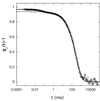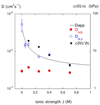Length scale dependence of the dynamic properties of hyaluronic acid solutions in the presence of salt
- PMID: 21049966
- PMCID: PMC3615649
- DOI: 10.1021/jp106578f
Length scale dependence of the dynamic properties of hyaluronic acid solutions in the presence of salt
Abstract
In solutions of the charged semirigid biopolymer hyaluronic acid in salt-free conditions, the diffusion coefficient D(NSE) measured at high transfer momentum q by neutron spin echo is more than an order of magnitude smaller than that determined by dynamic light scattering, D(DLS). This behavior contrasts with neutral polymer solutions. With increasing salt content, D(DLS) approaches D(NSE), which is independent of ionic strength. Contrary to theoretical expectation, the ion-polymer coupling, which dominates the low q dynamics of polyelectrolyte solutions, already breaks down at distance scales greater than the Debye-Hückel length.
Figures









Similar articles
-
Ions in hyaluronic acid solutions.J Chem Phys. 2009 Nov 14;131(18):184902. doi: 10.1063/1.3262308. J Chem Phys. 2009. PMID: 19916626 Free PMC article.
-
Scaling equations for a biopolymer in salt solution.Phys Rev Lett. 2007 Dec 31;99(26):267801. doi: 10.1103/PhysRevLett.99.267801. Epub 2007 Dec 26. Phys Rev Lett. 2007. PMID: 18233606
-
A micro-rheological and rheological study of biopolymers solutions: Hyaluronic acid.Carbohydr Polym. 2019 Jan 1;203:349-355. doi: 10.1016/j.carbpol.2018.09.072. Epub 2018 Sep 28. Carbohydr Polym. 2019. PMID: 30318222
-
Aggrecan, an unusual polyelectrolyte: review of solution behavior and physiological implications.Acta Biomater. 2012 Jan;8(1):3-12. doi: 10.1016/j.actbio.2011.08.011. Epub 2011 Aug 17. Acta Biomater. 2012. PMID: 21884828 Free PMC article. Review.
-
Experimental approaches to hyaluronan structure.Carbohydr Res. 2005 Apr 11;340(5):791-809. doi: 10.1016/j.carres.2005.01.022. Carbohydr Res. 2005. PMID: 15780246 Review.
Cited by
-
Spatially-Resolved Network Dynamics of Poly(vinyl alcohol) Gels Measured with Dynamic Small Angle Light Scattering.Gels. 2022 Jun 22;8(7):394. doi: 10.3390/gels8070394. Gels. 2022. PMID: 35877479 Free PMC article.
References
-
- de Gennes PG. Scaling Concepts in Polymer Physics. Ithaca, NY: Cornell; 1979.
-
- Muthukumar M. J. Chem. Phys. 2004;120:9343. - PubMed
-
- Zhang Y, Douglas JF, Ermi BD, Amis E. J. Chem. Phys. 2001;114:3299.
-
- Mezei F. Neutron Spin Echo, Lecture Notes in Physics. Vol. 128. Berlin: Springer; 1980.
-
- Hecht A-M, Guillermo A, Horkay F, Mallam S, Legrand JF, Geissler E. Macromolecules. 1992;25:3677.
Publication types
MeSH terms
Substances
Grants and funding
LinkOut - more resources
Full Text Sources

